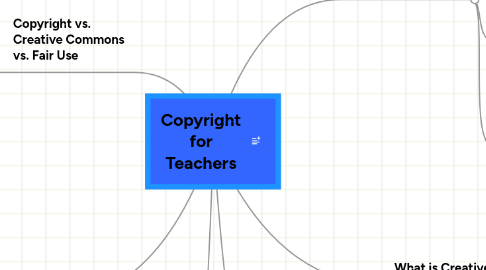
1. Material For Teachers
1.1. Copyright lessons for your students:
1.2. More information for kids:
2. Copyright vs. Creative Commons vs. Fair Use
2.1. Similarities
2.1.1. all of these rights were created in order to support people who have created things, and respect their wishes as to how their creations are to be treated
2.1.2. These are all respected and upheld by the US court
2.2. Differences
2.2.1. Copyright is automatically applied to any original work that is created, while a creator needs to apply for a Creative Commons.
2.2.2. A courts ruling for Fair Use can have very different conclusions depending on each case.
2.2.2.1. Because the world is quickly developing, cases that are similar can have very different conclusions depending on the year it was addressed.
2.2.3. While there is a marking symbol for 'Copyrighted', not everything under the law is marked because works are all assumed to be under this law. Creative Commons material is separately marked with a circled 'cc'.
3. What is Copyright?
3.1. The documentation that after something is created, it is immediately owned by the creator. They have "all rights reserved".
3.1.1. The governments Copyright website:
3.2. Original works are automatically covered in the Copyright law, and so materials under the law may not be marked with the circled 'c'.
4. What is Fair Use?
4.1. Fair Use is the restriction of use of others material or works. This protects creators against people taking advantage of their work.
4.1.1. For more information:
4.2. Four Criteria
4.2.1. What is the nature of the work? How much of it is fiction vs non-fiction? How creative is the piece?
4.2.2. How much of it are you using?
4.2.3. Why are you using it? What is the purpose/character or the use?
4.2.3.1. commercial vs non-commercial
4.2.4. What affect are you going to have on the market of the piece of work?
4.2.4.1. Are you potentially going to take money from the creator?
4.3. For more information, a discussion:
4.4. It is important for Teachers to understand Fair Use because a good teacher uses material from many different sources, and the teacher must be aware of the restrictions placed on the use of the material
4.4.1. Many sources offer special use to teachers, because they are using the material for educational purposes.
4.4.1.1. If a teacher shows pictures to a class and the pictures are protected by Creative Commons, the teacher may not be doing anything wrong. If the work is copyrighted, they may be overstepping the copyright law.
4.4.1.2. When searching online for material, teachers need to be aware of labels. If a piece of work is labeled with 'cc', then they need to research further as to the extent of the coverage.
5. What is Creative Commons?
5.1. A way for creators to have "some rights reserved" on their work, as opposed to "all rights reserved"
5.1.1. A work that is covered by Creative Commons will be marked by a circled 'cc'.
5.2. Their website:
5.3. A creator is able to choose what degree of coverage their copyright covers. This includes whether or not their work can be used for commercial use.
6. How to Stay Informed
6.1. Teachers should stay well-informed about Copyright laws, Fair Use, and newer movements such as Creative Commons.
6.1.1. Visit the Creative Commons website posted above, and familiarize yourself with the material.
